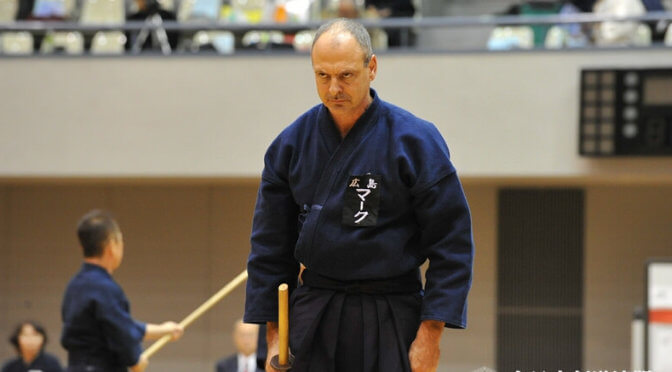Karate-Do
Sho-ha Shorin-ryu Karate-do was officially established by Sensei John Hamilton on December 22, 2002. The Sho-ha system has its roots in the Okinawan Shorin-ryu karate of Sensei Shimabuku(ro) Eizo, as taught to Sensei Hamilton by Sensei Glenn Premru. Mr. Premru had studied both directly under Sensei Shimabuku(ro) and under Sensei Sam Pearson. Mr. Pearson had been a student of Sensei Shimabuku(ro) in Okinawa.
Sensei Hamilton’s time with Mr. Premru began in his early teens and lasted more than a decade, until Mr. Premru moved out of state. Following his instructor’s departure, Sensei Hamilton began operating his own dojo. Gradually over the years he made several modifications to the Shorin-ryu karate that he had been taught. These modifications were born of his own insight and experimentation, as well as of the influence of various other teachers.
Some forty-plus years after beginning his karate training, Sensei Hamilton felt that he was ready to officially establish “his” karate, and named the system Sho-ha Shorin-ryu Karate-do. The word ha is Japanese for “faction” or “sub-group.” Sho means “first” or “beginning,” and is the name that Sensei Hamilton has chosen for himself. ( It is a custom of the Sho-ha Shorin-ryu that, upon reaching a certain rank level, one chooses a Japanese character or characters as one’s karate “name.”) In essence, then, Sho-ha Shorin-ryu Karate-do simply means “the Shorin-ryu karate that Hamilton’s group practices.”
Jodo
The history of jodo – written in Japanese as 杖道, and literally meaning “the way of the stick” – begins with a single samurai, a man most commonly known as “Muso Gonnosuke.”
Originally known as “Hirano Gonbei,” Muso Gonnosuke lived during the late 16th and early 17th centuries. He is most typically said to have trained in both Tenshin Shoden Katori Shinto-ryu and another classical martial art. Having become quite an accomplished practitioner, he engaged in several matches with well-known warriors of the time as a way of testing and improving his skills. He is said to have remained undefeated until the day that he met Miyamoto Musashi. After his loss to Musashi, Muso traveled to what is present-day northwest Fukuoka Prefecture. There, at a Shinto shrine on a mountain called “Homanzan,” he is said to have spent 37 (or some other number of) days praying (and/or meditating, performing acts of austerity, perhaps training, etc.). On the night of his final day, Muso had a dream that brought him a divine message. Said by at least some to have been delivered by a child who appeared in the dream, the message was, “Maruki wo motte, suigetsu wo shire.” Depending on the meaning that one ascribes to the words “motte” and “suigetsu,” a translation might be something such as “holding / using a log / round stick, know the interval(s) / the body’s vital point(s).”
As obscure as Muso’s message may seem, it lead him to create a new weapon—a short staff, or jo—and techniques for the use of that weapon.

The characteristics of Sho-ha Shorin-ryu Karate-do can be summarized as:
1. Practical Self-Defense Orientation
Over the years, as karate has made its way from its birthplace of Okinawa to mainland Japan, and then to the rest of the world, the orientation of training has tended to shift toward emphasizing competition and contests. Tournament competition has become widespread, and even schools which do not participate in formal contests often train in a way that treats karate as more of a sport than a method of self-defense. Sho-ha Shorin-ryu, on the other hand (although certainly not the only style to do so), chooses to not concern itself with such sport-based and sport-like activities, focusing rather on the original, practical self-defense aims of the art. Thus, only those techniques, strategies, etc., that can successfully be applied in real-world self-defense situations are taught and practiced.
2. Efficient, Biomechanically-Sound Movement
Convinced that the structure and function of the human body determine the most efficient and effective ways of moving, the founder of Sho-ha Shorin-ryu karate, John Hamilton Sensei, has spent years studying these things. His findings have been incorporated into each and every technique of the Sho-ha Shorin-ryu.
3. Integrated Training Approach
In many – if not most – karate schools, practice takes the form of three components which, for the most part, are treated as unrelated: kata(prearranged series of techniques carried out one after another), kumite or sparring, and self-defense practice. Sho-ha Shorin-ryu karate principles, however, state that one’s self-defense, sparring and kata techniques should all be closely related (if not the same), and that the practice of any one of these components should be the practice of realistic, effective techniques of self-protection also found in one’s other forms of training. Thus, the performance of katamovements whose meanings are not understood, sport-based sparring methods, and self-defense techniques that are unrelated to one’s other practice are all avoided.
4. Traditional Training Atmosphere
Training in a Sho-ha Shorin-ryu karate dojo or school takes place in an atmosphere of respect. Traditional Japanese martial art etiquette, which emphasizes respect for one’s teacher, one’s fellow students, ones’s dojo and one’s ryuha (style), is strictly followed.
5. Attention to Maintenance of a Healthy Body
It is a stated goal of Sho-ha Shorin-ryu karate that one’s training should enhance one’s health, not have a negative impact on it. Founder John Hamilton has consciously striven to eliminate any practices that are destructive to the body, as well as worked to develop ways of maintaining balance in the muscular-skeletal system. It is the expectation in Sho-ha Shorin-ryu that students will be able to continue their training well into their advanced years.